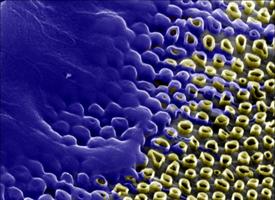Carbon Nanotube-Based Device Efficiently Transports Nucleic Acids into Cell Cultures
By LabMedica International staff writers
Posted on 25 Apr 2016
A novel device based on carbon nanotubes arranged in "honeycomb-like" structures was used to safely and efficiently transfer genetic material into cultures of different types of human and animal cells.Posted on 25 Apr 2016
The introduction of nucleic acids into mammalian cells is a crucial step toward elucidating biochemical pathways and for modifying gene expression and cellular development in immortalized cells, primary cells, and stem cells. Current transfection technologies—such as electrical pulse, gene gun inoculation, and employing viral infection—are time consuming and limited by the size of the genetic cargo that can be transferred, the inefficient introduction of test molecules into large populations of target cells, and the cytotoxicity of the techniques.

Image: A scanning electron microscope (SEM) image of animal cells (colored blue) cultured on an array of carbon nanotubes (Photo courtesy of the University of Rochester).
Investigators at the University of Rochester (NY, USA) have reported the development of a novel method of introducing genes and biomolecules into tens of thousands of mammalian cells through an array of aligned hollow carbon nanotubes. The device was prepared using the process of chemical vapor deposition that resulted in a structure resembling a nano-sized honeycomb consisting of millions of densely packed carbon nanotubes with openings on both sides of a thin disk shaped membrane.
In a paper published in the April 5, 2016, online edition of the journal Small, the investigators described using the device to culture a series of different human and animal cells. After 48 hours, the cells were bathed in a DNA-enriched liquid medium. The carbon nanotubes acted as conduits drawing the genetic material into the cells in a mild fashion that preserved 98% of the cells with 85% successfully transfected with the new genetic material.
"This represents a very simple, inexpensive, and efficient process that is well tolerated by cells and can successfully deliver DNA into tens of thousands of cells simultaneously," said senior author Dr. Michael Schrlau, assistant professor of engineering at the University of Rochester.
Related Links:
University of Rochester




 assay.jpg)








